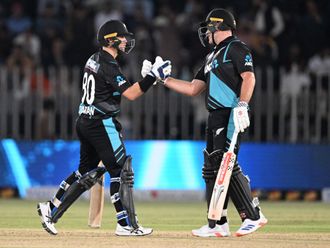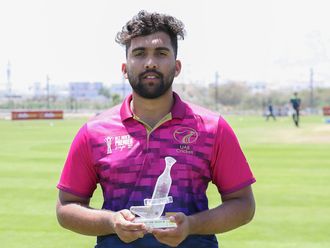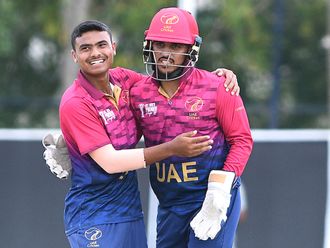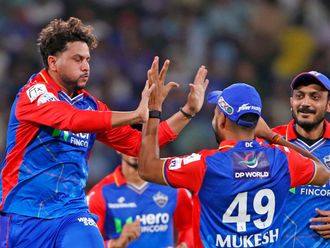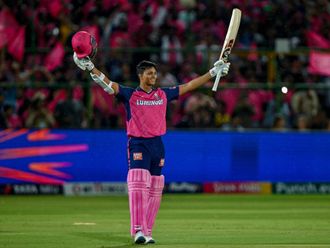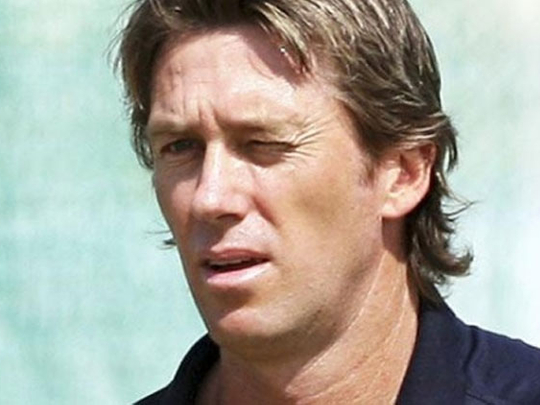
Dubai: Nothing quite stirs the senses of cricket followers than the sight of a fearsome fast bowler in full flow: His blistering pace, his snarling demeanour and the venomous intent with which he hurls the ball at quivering batsmen like a grenade in a bid to detonate the stumps.
A fiery spell of fast bowling engenders a visceral thrill which can transform a normally sedate crowd into a baying mob, vicariously invigorated by the fast bowler’s adrenaline-fuelled onslaughts.
One of the best exponents of this pulsating art of destruction was Australian great Dennis Lillee, the mustachioed marauder of the 1970s and early 80s.
He formed a lethal partnership with fellow prodigious paceman Jeff Thomson, taking 355 wickets in just 70 Test matches, and was renowned for his combustible temperament and never-say-die attitude.
Certainly, for a young Glenn McGrath, another legendary former Australia bowler, Lillee had no peers when it came to epitomising the intoxicating velocity and ferocity of fast bowling.
“It was the aura that Dennis had [that impressed me most], he was the ultimate fast bowler,” said McGrath, who retired from the game in 2007, in an exclusive telephone interview with Gulf News from India. “He definitely was a character, who bowled aggressively and wore a big, white headband. He used to put a finger across his brow and flick the sweat off.
“I loved cricket growing up and that was the era of the Chappells [Ian and Greg], Rod Marsh, Dennis Lillee and ‘Thommo’ [Jeff Thomson]. Dennis was one of best fast bowlers of all time as well as being the best, or one of the best, fast-bowling coaches in the world.”
McGrath therefore fulfilled a childhood dream when his boyhood hero coached him during his illustrious career at the MRF Pace Foundation in Chennai, India, which nurtures the talents of young Indian pace bowlers.
There would be a further propitious quirk of fate involving McGrath and Lillee, when in September 2012 the apprentice accepted an offer from the master to replace him as director of the foundation.
The coaching clinic, which was set up by the Madras Rubber Factory Limited with the assistance of Lillee in 1987 at the campus of Madras Christian College Higher Secondary School, has helped hone the skills of a number of famous India bowlers over the years.
They include Zaheer Khan, Venkatesh Prasad and Irfan Pathan, while India’s most revered cricketer, the former batting maestro Sachin Tendulkar, trained there during his school days.
The clinic has also welcomed bowlers from overseas, such as McGrath and his fellow countryman Brett Lee, Shoaib Akhtar of Pakistan, Sri Lanka’s Chaminda Vaas and Zimbabwe’s Heath Streak.
McGrath, the fourth-highest Test wicket-taker of all time with 563 wickets from 124 matches, said: “The whole idea was to find the next, or create the next, Indian fast bowler. There have never been real express ones, so that’s what it’s been trying to develop. Dennis thought it was time to hand over the reins to someone else and asked me if I’d take over.”
McGrath was only too happy to agree and says he has greatly enjoyed the challenge.
He spends three two-week stints a year at the academy, which currently coaches 16 to 18 young Indian fast bowlers aged between 18 and 23 and five Australian bowlers and a spinner-batsman.
“We work with them technically, mentally and physically on everything to do with cricket,” he added. “A lot of them stay here full time and they get good food and training here. I think it’s a great concept and the thing that got me across the line was that I wouldn’t just be working with Indian bowlers, but potentially young bowlers from Australia, England, South Africa, Sri Lanka and the West Indies.”
Two academy graduates are currently part of India’s touring party in England — Varun Aaron and Ishwar Pandey — and McGrath predicts they can excel if given the chance to put into practice his expertise.
“I think Varun Aaron has been to England before [in 2011] and did reasonably well, so I hope he gets the opportunity,” said the 44-year-old. “Then we have Ishwar Pandey and I think given opportunity, he will do exceptionally well, especially in English conditions.”
He went on: “I’ve just chatted to them about bowling in England, how different it is compared to the Indian wickets and the fact they use the Duke cricket ball compared to the SG, which they use here in India.
“It’s been a case of giving them a bit of advice about the length to bowl, how the ball might swing a bit more. There are no slow, low wickets that they are used to here, so it’s about bowling the right length as soon as possible and enjoying the conditions, all pretty basic stuff.
“They definitely have the ability; Varun Aaron has good pace, fairly good control and Ishwar Pandey bowls in great areas has good control and can bowl all day. Fingers crossed they get the opportunity [to play].”
McGrath added that of his current crop, there are no ‘out-and-out express-pace bowlers’, but that everyone is‘improving all the time’.
He said 21-year-old left-arm, medium-pace bowler Royston Dias, who played for Delhi Daredevils in the 2013 Indian Premier League, was one to watch for the future.
“He’ll be heading over to Australia soon to do some work at the cricket academy there,” McGrath said.
So what are the central tenets of fast bowling which he preaches to his students?
He says that control in the bowling action — he was famed for his metronomic ability to bowl in the right areas in the absence of searing pace — is vital, with a good, sound action and technique ensuring longevity and helping stave off injury.
Aside from being quick and physically fit, McGrath says outward shows of aggression and steely self-belief are other essential weapons in a fast bowler’s armoury.
Such traits do not come naturally to most Indian bowlers, he admits, who prefer to outwit their opponents with the sorcery of spin rather than bludgeon them with a barrage of hostile deliveries and insults.
“As a fast bowler, you do need a little bit of aggression, and Indian bowlers have shown a bit of aggression but not what we in Australia call that real mongrel,” he said. “It’s not about sledging — everyone carries on about sledging and chat on the field and some teams are more up front about that than others, with Australian teams never trying to hide it.
“But every team has chat in middle and that’s part of the test of playing international cricket or international sport. You have got to be able to handle those things and I think it’s more about body language and attitude on the field. Also the length you’re bowling, whether it’s intimidating short bowling with aggressive fields.
“You have got to have that self-belief and hold yourself well. You can’t drop your head or mope around and drop your shoulders. Body language plays a big part in aggression side of things.”
It’s clear that McGrath has much to offer as a coach — he commands instant respect as being one of the greatest bowlers in history and has a down-to-earth manner to which young cricketing minds would readily respond.
So, having caught the coaching bug, where does he see his future as a mentor to young up-and-coming talents?
Would he be interested in helping develop cricket in a burgeoning centre of the game such as the UAE, for instance?
“When I retired, I thought coaching was something I didn’t want to get into,” he said. “And in the 18 months and more that I’ve been here at the MRF Pace Foundation, the amount that I’ve learned has been amazing. I wish I knew now what I know about fast bowling when I played, as I’d have been a far better bowler.
“It’s also given me a lot of confidence potentially and definitely I feel have a lot to offer and I know now how to go about it a bit more. I am learning more every time I come here. Who knows what the future holds? I am keen to do more in cricket, so who knows? I could come over there as well.”
I question why cricket chiefs in his homeland are not utilising his mentoring skills, but McGrath says that will happen soon when he visits Cricket Australia’s academy in Brisbane.
Yet becoming a full-time coach of Australia does not interest him due to the time away from his family any such role would involve.
He said: “I think that’s not one of my goals at the moment and one of my goals when I retired was to spend more time at home after so much time on the road.
“I was talking to Troy Cooley, head coach of the cricket academy back home, who is over here at the moment. He said that when he was the Australian bowling coach, he spent 260 days away from home a year. It’s a big time commitment. I don’t want to spend that much time away from home anymore.
“Craig McDermott is the Australian bowling coach and he’s doing exceptionally well. So I am more than happy to let him do it as long as he wants.”



